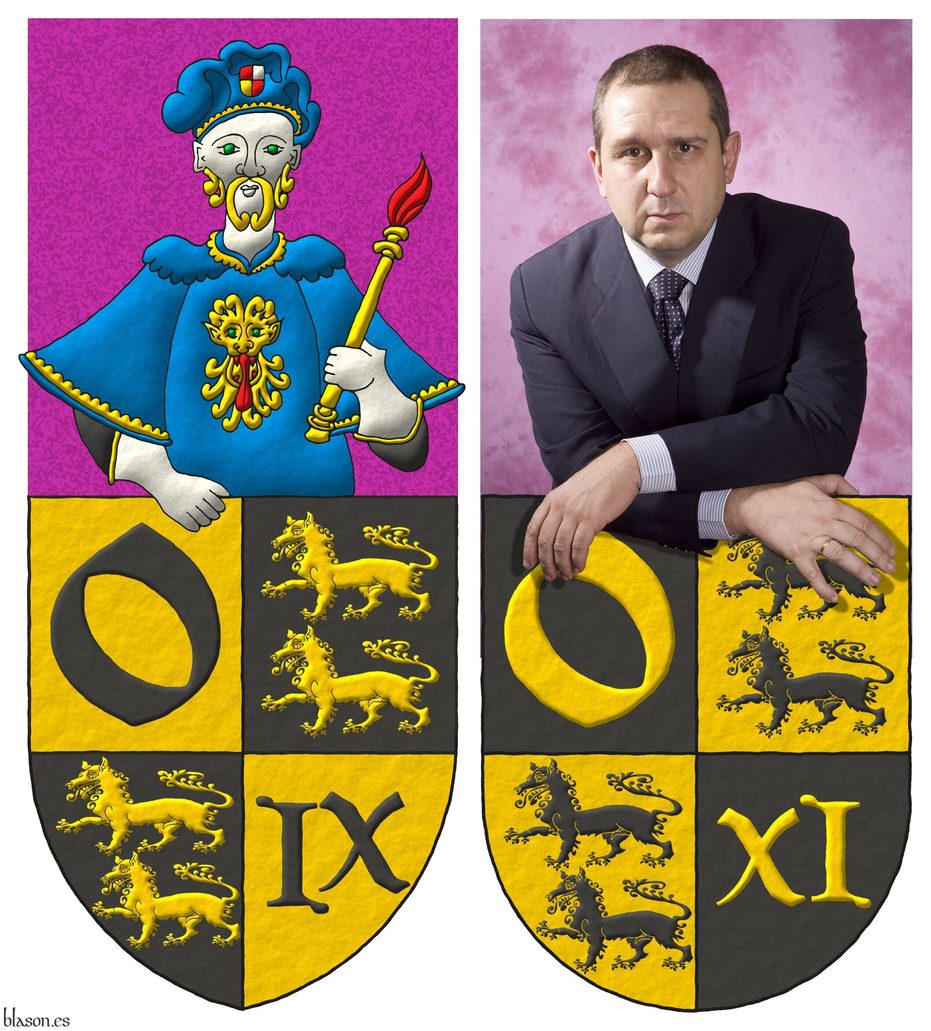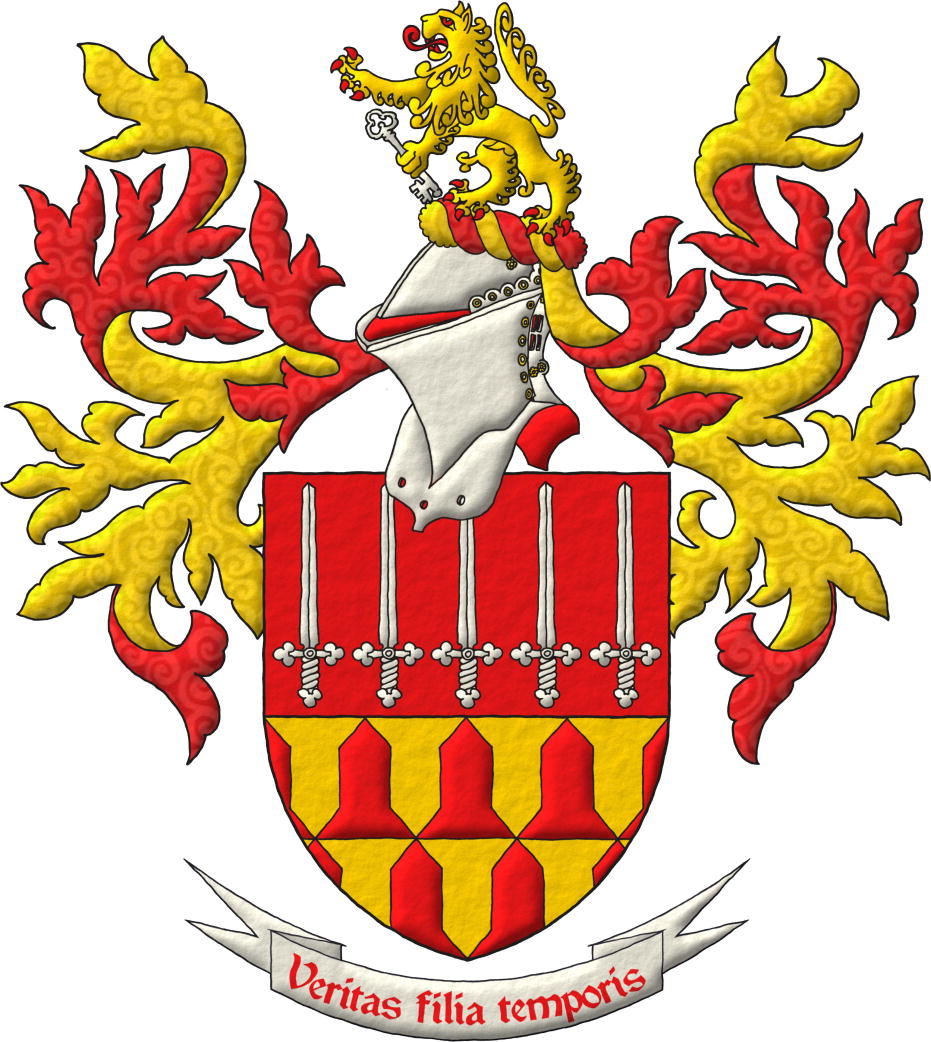
![Ver [Shakespeare, W.; 1608] en referencias bibliográficas. Libro abierto, hojas de plata, filo de oro, guardas de gules, tapas de sable.](../css/Libro.Bibliografia.png)
Shakespeare, W.; 1608

William Shakespeare, «Coriolanus», Tragedy in 5 acts and 29 scenes, written in verse, dated to either 1608 or 1609, depending on the sources.
It is one of the last works written by William Shakespeare, a tragedy based on the life of Caius Marcius Coriolanus, a legendary Roman general from the 5th century B.C. Some authors consider General Coriolanus to be a historical figure, while others do not.
Initially known only as Caius Marcius, during the war against the Volsci he becomes a hero by entering the city of Corioli with a few soldiers, and from then on, he is called Caius Marcius Coriolanus.
Act 3, Scene 2, Volumnia, mother of Coriolanus
I prithee now, my son,
Go to them, with this bonnet in thy hand;
And thus far having stretch'd it (here be with them)
Thy knee bussing the stones (for in such business
Action is eloquence, and the eyes of the ignorant
More learned than the ears) waving thy head,
Which often, thus, correcting thy stout heart,
Now humble as the ripest mulberry
That will not hold the handling: or say to them,
Thou art their soldier, and being bred in broils
Hast not the soft way which, thou dost confess,
Were fit for thee to use as they to claim,
In asking their good loves, but thou wilt frame
Thyself, forsooth, hereafter theirs, so far
As thou hast power and person.
Bibliographical reference of century XVII.
The author is Shakespeare, William.
External link:


![Ver [St. George's Roll; 1285] en referencias bibliográficas. Libro abierto, hojas de plata, filo de oro, guardas de gules, tapas de sable.](../css/Libro.Bibliografia.png)
St. George's Roll; 1285

St. George's Roll, in English usually written as «MS Vincent, 164 ff.1-21b», also called [Vincent, MS; 1285], it is in the College of Arms, London, containing 677 painted coats of arms, it is an English roll or arms dating from c. 1285.
The bibliographical reference that I mainly use for this armorial is [Vincent, MS; 1285].
Bibliographical reference of century XIII.
Classification: Armorial roll and Manuscript.
The author is unknown.
Bibliographic reference mentioned in the following articles:
- Adam de Cretingges
- Bartholomew de Yattendon
- Brian Timms
- Edmund de Bassingburnn
- Howel ap Res
- James de Sottone, le Fitz
- Joan de Okinton
- John de Beauchamp
- John de Ladbrooke
- John le Sturmy
- Nicholas Malmains
- Norman Darcy
- Ricardo de Mandeville
- Robert de Malet
- Simon de Crombe
- Simon de Ver
- Simon le FizSimon
- Thomas Roscelyn
- Thomas de Werblintone
- Thomas le FizThomas
- Vincent, MS; 1285
- Warbrentone, Thomas de
- William Bardolf
- William de Ferrers, Earl of Derby
- William de Hondeshacre


![Ver [Heralds International] en enlaces recomendados. Áncora de oro y la divisa enlace.](../css/Ancora.Enlace.png)
Heralds International

Internet addresses:
I was honored with their announce of my incorporation to Heralds International, the announce was the following:
- «Dr. Antonio Salmeron has recently joined Heralds International as a Member Artist and so we thought we would feature some of his work. A longer article will follow later but Dr. Salmeron has described his work thus»:
- «My style as a heraldic artist is clear, symbolic and methodical. Clear because my work searches pieces which transmit energy and vital force to the owner, I think that a coat of arms should be a source of light and joy and an expression of freedom. Symbolic because coats of arms must be a representation of its bearer, his/her ideals, motivations, history and anything he/she might want to display. Methodical because heraldic art is founded on a science, the so called science of heraldry».
- «We look forward to featuring more of his work very soon».
Categories: Link and Heraldry and heralds.


![Ver [Vincent, MS; 1285] en referencias bibliográficas. Libro abierto, hojas de plata, filo de oro, guardas de gules, tapas de sable.](../css/Libro.Bibliografia.png)
Vincent, MS; 1285
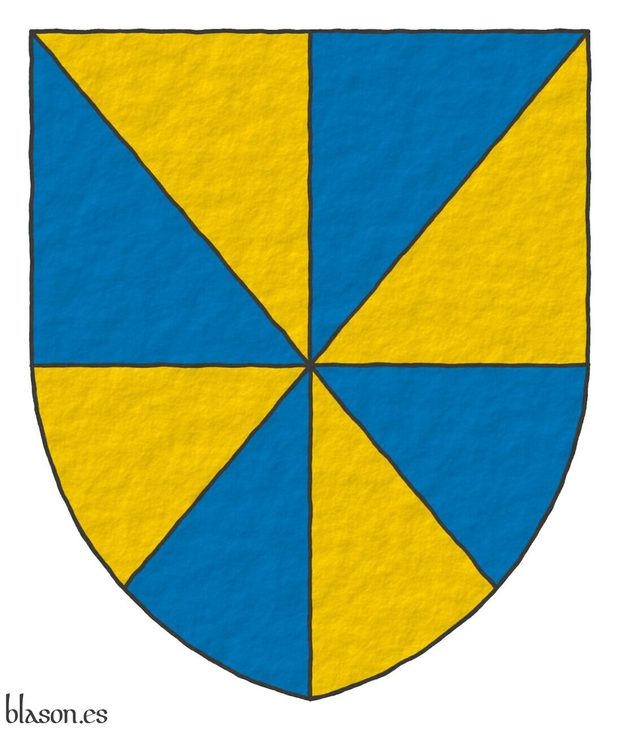
Vincent Manuscript, in English, usually written as «MS Vincent, 164 ff.1-21b», also called [St. George's Roll; 1285], it is in the College of Arms, London, containing 677 painted coats of arms, it is an English roll of arms dating from c. 1285.
Bibliographical reference of century XIII.
Classification: Armorial roll, Manuscript and In color.
Author: unknown.
Here are the articles quoting this reference:
- Adam de Cretingges
- Bartholomew de Yattendon
- Edmund de Bassingburnn
- Howel ap Res
- James de Sottone, le Fitz
- Joan de Okinton
- John de Beauchamp
- John de Ladbrooke
- John le Sturmy
- Nicholas Malmains
- Norman Darcy
- Ricardo de Mandeville
- Robert de Malet
- Simon de Crombe
- Simon de Ver
- Simon le FizSimon
- St. George's Roll; 1285
- Thomas Roscelyn
- Thomas de Werblintone
- Thomas le FizThomas
- William Bardolf
- William de Ferrers, Earl of Derby
- William de Hondeshacre


![Ver [Wijnbergen; 1265] en referencias bibliográficas. Libro abierto, hojas de plata, filo de oro, guardas de gules, tapas de sable.](../css/Libro.Bibliografia.png)
Wijnbergen; 1265
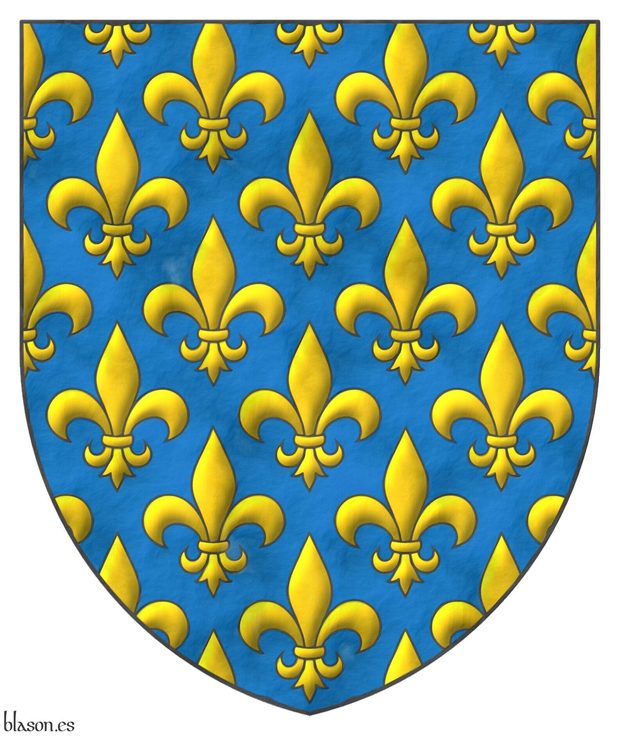
Wijnbergen, unknown authors, «Wijnbergen Armorial», currently located in The Hague and owned by the Royal Dutch Society of Genealogy and Heraldry, Île-de-France, 1265.
This armorial is called «Wijnbergen» because it was named after one of its early owners, and the names of its authors are unknown. I have retained this name in the key to this bibliographic reference for easier identification.
Among known manuscripts, it is the oldest armorial of French heraldry.
It is composed of 15 parts, although some authors divide it into 23, belonging to 2 different temporal stages of creation: a 1st stage from 1265 to 1270 and a 2nd stage, more difficult to date, from 1270 to 1285.
The armorial is written in French and contains a total of 1,312 coats of arms, of which 256 belong to the 1st stage and 1,056 to the 2nd stage.
Those of the 1st stage belong to the vassals of the Île-de-France under the reign of Luis IX de Francia, Saint Louis King of France.
Those of the 2nd stage, probably already under the reign of Felipe III de Francia, contain coats of arms from Normandy, Anjou and Poitou, Lorraine, Germany, Artois, Champagne, Vermandois, Brittany, Beauvais, Burgundy, Brabant, Hainaut (Belgium), Flanders, and finally, the coats of arms of 25 kings, mainly European.
Bibliographical reference of century XIII.
Author: Wijnbergen, Anonymous.
The following articles cite this bibliographic reference:
External resources:


Martos García, Juan Carlos
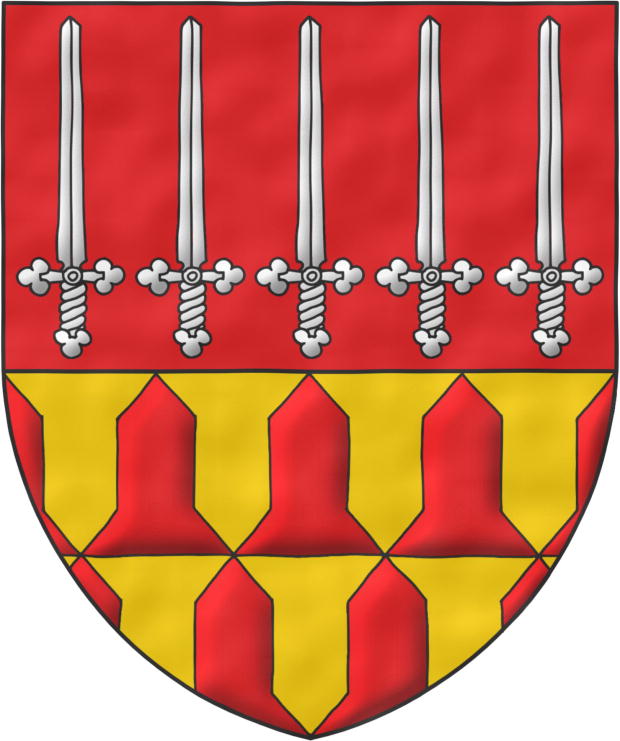
Party per fess: 1 Gules, five swords erect, in fess Argent; 2 Vairy Or and Gules.
Escudo cortado: 1o de gules, cinco espadas alzadas, en faja de plata; 2o verado de oro y gules.
Coat of arms that I have created with: a pointed base of the shield; the first field enamelled with flat Gules ink; the second field enamelled with flat Or ink; the swords and the vairy are illuminated; and the whole has received a watercolor finish.
Symbolism
There are 6 swords erect to defend the vairy of truth and, no matter how much time passes, they will not relent until the truth prevails.
Blazon keywords: Party per fess, Gules, Or, Argent, Five, Sword, Vairy, Point upwards and In fess.
Style keywords: Pointed, Illuminated, Outlined in sable and Watercolor.
Classification: Created, Personal and Coat of arms.
Bearer: Martos García, Juan Carlos.


Martos García, J. C., a supporter
Party per fess: 1 Gules, five swords erect, in fess Argent; 2 Vairy Or and Gules.
Escudo cortado: 1o de gules, cinco espadas de plata, alzadas, en faja; 2o verado de oro y gules. Soporte: Un león de oro, rampante, armado, lampasado, fierezado y encendido de gules a la siniestra.
Supporter and shield inclined to dexter with: a pointed base of the shield; its two fields enamelled with flat inks, Gules and Or respectively; the rest of the elements illuminated; everything outlined in Sable; and the whole executed with a raised-stroke technique.
Blazon keywords: Party per fess, Gules, Or, Argent, Five, Sword, Point upwards, In fess, Vairy, Lion, Rampant, Armed, Langued, The fangs, The eyes, Supporter (animal) and Supporter.
Style keywords: Pointed, Illuminated, Outlined in sable and Freehand.
Classification: Created, Personal and Coat of arms.
Bearer: Martos García, Juan Carlos.


Martos García, J. C., crest
Party per fess: 1 Gules, five swords erect, in fess Argent; 2 Vairy Or and Gules. Crest: Upon a helm with a wreath Or and Gules, a lion rampant Or, armed, langued, the fangs and the eyes Gules, grasping in its sinister paw a key Argent. Mantling: Gules doubled Or. Motto: «Veritas filia temporis» Gules over a scroll Argent.
Escudo cortado: 1o de gules, cinco espadas alzadas, en faja de plata; 2o verado de oro y gules. Timbrado de un yelmo, adornado de dos lambrequines de gules doblados de oro, un burelete de oro y gules, cimado de un león rampante de oro, armado, lampasado, fierezado y encendido de gules, teniendo en la siniestra una llave de plata. Lema: «Veritas filia temporis» de gules sobre una filacteria de plata.
Coat of arms with its crest made as follows: a pointed base; its two fields enamelled with flat inks, Gules and Or; the rest illuminated and outlined in Sable; the torse and mantling diapered with chinapiería; and the whole in raised-stroke.
Blazon keywords: Party per fess, Gules, Or, Argent, Five, Sword, Point upwards, In fess, Vairy, Crest and mantling, Helm, Mantling, Wreath, Crest, Lion, Rampant, Armed, Langued, The fangs, The eyes, Sinister, Grasping, Key and Motto.
Style keywords: Pointed, Illuminated, Outlined in sable and Freehand.
Classification: Created, Personal and Coat of arms.
Bearer: Martos García, Juan Carlos.

Continue with: Martos García, J. C., crest and supporters.
-
Language
-
Categories of heraldry
-
Divisions of the field
- Without divisions
- Party per pale
- Party per fess
- Party per bend
- Party per bend sinister
- Tierce
- Tierce sinister
- Tierced per pale
- Tierced per fess
- Tierced per bend
- Tierced pallwise inverted
- Quarterly
- Quarterly per saltire
- Gyronny
- Party per fess, the chief per pale
- Party per pale, the sinister per fess
- Party per fess, the base per pale
- Party per pale, the dexter per fess
- Chapé
- Chaussé
- Embrassé
- Contre-embrassé
- Party per chevron
- Enté
- Enté en point
- Flanched
-
Metals
-
Colours
-
Furs
-
Other tinctures
-
Ordinaries and sub-ordinaries
-
Diminutives of the ordinaries
-
Geometric charges
-
Composite ordinaries
-
Inanimate charges from Nature
Atom, Crescent, Diamond, Emerald, Estoile, Increscent, Lightning flash, Moon, Mount, Mullet, Mullet of four points, Orbital, Plough of Ursa Major, Rainbow, Ray of the sun, River, Sea, Snowflake, Sun, Sun in splendour, Sun of May, Trimount, Water and Wave.
-
Vegetal charges from Nature
Acorn, Apple, Apple tree, Ash, Bluebonnet, Camellia, Chrysanthemum, Cinquefoil, Cornflower, Dogwood flower, Double rose, Elm, Fleur de lis, Flower, Gourd, Holm oak, Hop cone, Indian paintbrush, Kapok tree, Laurel, Lily, Linden, Lotus flower, Madonna lily, Mexican cedar tree, Oak, Olive tree, Palm tree, Plantain plant, Pomegranate, Poplar leaf, Rose, Shamrock, Sunflower, Thistle, Tree, Tulip, Vine and Wheat.
-
Animal charges from Nature
Badger, Bald eagle, Barbel, Barn owl, Bear, Beaver, Bee, Beetle, Bighorn sheep, Binson, Blackbird, Boar, Brach hound, Bull, Doe, Dog, Dolphin, Dove, Eagle, Elephant, Falcon, Female figure, Fish, Flame, Fly, Fox, Frog, Goat, Goldfinch, Goose, Heron, Horse, Hummingbird, Jaguar, Lark, Leopard, Lion, Lion passant, Lion rampant guardant, Lioness, Lynx, Male figure, Martlet, Merino ram, Owl, Panther, Parrot, Peacock, Pelican, Pelican in her piety, Pronghorn, Puffin, Quetzal, Raven, Roe deer, Rooster, Savage, Seagull, Serpent, She-wolf, Stag, Starling, Talbot, Tyger, Vulture, Warren hound and Wolf.
-
Parts of natural charges
Arm, Beak, Branch, Caboshed, Chest, Claw, Covert, Dorsal fin, Eagle claw, Ermine spot, Escallop, Feather, Foot (palmiped), Foreleg, Forepaw, Hand, Head, Heart, Hoof, Leaf, Neck, Ostrich feather, Palm frond, Paw, Roe deers' attires, Shoulder, Sprig, Stags' attires, Stem, Swallow-tail, Tail, Tail addorsed, Tail fin, Talon, Tibia, Tooth, Trunk, Trunk (elephant), Two hands clasped, Two wings in vol, Udder, Wheat spike, Wing and Wrist.
-
Artificial charges
Ace of spades, Anchor, Anvil, Arch, Arm vambraced, Armillary sphere, Arrow, Axe, Bell, Bell tower, Beret, Bonfire, Book, Bookmark, Bow, Branding iron, Bridge, Broken, Buckle, Cannon, Cannon dismounted, Cannon port, Canopy roof, Carbuncle, Castle, Celtic Trinity knot, Chain, Chess rooks, Church, Clarion, Clay pot, Closed book, Club, Column, Comb, Compass rose, Conductor's baton, Cord, Covered cup, Crozier, Crucible, Cuffed, Cup, Cyclamor, Dagger, Double vajra, Drum, Ecclesiastical cap, Fanon, Federschwert, Fleam, Four crescents joined millsailwise, Galician granary, Garb, Gauntlet, Geometric solid, Grenade, Halberd, Hammer, Harp, Host, Hourglass, Key, Key ward, Knight, Knot, Lantern, Letter, Line, Loincloth, Menorah, Millrind, Millstone, Millwheel, Monstrance, Mortar, Mullet of six points pierced, Nail, Non-classic artifact, Norman ship, Number, Oar, Oil lamp, Open book, Page, Pair of scales, Parchment, Pestle, Piano, Pilgrim's staff, Plough share, Polish winged hussar, Port, Portcullis, Potent, Quill, Ribbon, Rosette of acanthus leaves, Sabre, Sackbut, Sail, Scroll, Scythe, Sheaf of tobacco, Ship, Skirt, Spear, Spear's head, Stairway, Star of David, Step, Sword, Symbol, Tetrahedron, Torch, Tower, Trident, Trumpet, Turret, Two-handed sword, Wagon-wheel, Water-bouget, Wheel, Winnowing fan and With a turret.
-
Immaterial charges
Angel, Archangel, Basilisk, Dragon, Dragon's head, Garuda, Golden fleece, Griffin, Heart enflamed, Justice, Mermaid, Our Lady of Mercy, Ouroboros, Paschal lamb, Pegasus, Phoenix, Sacred Heart of Jesus, Saint George, Sea-griffin, Trinity, Triton, Unicorn, Winged hand and Wyvern.
-
External elements
-
Heraldic creations
-
References
-
Formats
-
Keywords on this page
Watercolor, Point upwards, Pointed, Armed, Armorial roll, Azure, Bend, Bibliography, Wreath, Charged, Heraldry and heralds, Crest, Five, Party per fess, Created, Outlined in sable, In color, In fess, The eyes, Link, Coat of arms, Sword, The fangs, Fleur de lis, Personal, Gules, Heralds International, Illuminated, Mantling, Langued, Motto, Lion, Key, Manuscript, Martos García, Juan Carlos, Or, Argent, Without divisions, Rampant, Kingdom of England, Century XIII, Sinister, Supporter (animal), Supporter, Grasping, Crest and mantling, Freehand, Vairy and Helm.

